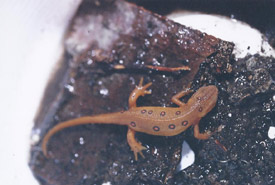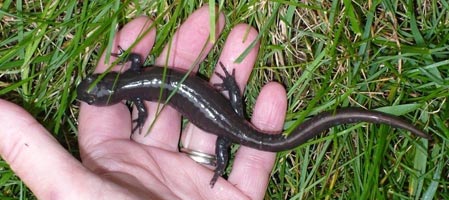Reptiles and amphibians of the Happy Valley Forest

Red eft (the immature form of the spotted newt) are the commonest reptile in the Happy Valley Forest and crowd the forest trails during egg-laying time. (Photo by Dr. Henry Barnett)
The reptile species in the Happy Valley Forest number 19. The area provides one of the last redoubts for the threatened Jefferson’s salamander. Red efts are common, red-backed and spotted salamanders will be regularly seen in the but the spotted salamanders are seldom noticed thereafter.
In several locations we regularly find mink frogs. Tree frogs are commonly seen and heard. Bull frogs are less frequent than earlier. Green and leopard frogs remain reasonably common. Very noisy after the first warm days are the cricket frogs, chorus frogs and the spring peepers; they are very plentiful.
The sound of the cricket and chorus frogs is a sure sign of evidence of the coming of spring. Just as is the first group of noisy crows and the persistent calling of the red-shouldered hawk.
Among the frogs, the blue-green tree frog moves inland and may be heard right at our windows and may adhere to the pane of the window. The green frog, wood frog and leopard frog will add to the clamour. The chorus frog, the cricket frog and the spring peeper collectively can be deafening at the edge of the water.
Ontario boasts only one toad species with a delightfully monotonous trill, which adds to the noise of the frogs. It makes me think of the summer and a jazz band!

Jefferson's salamander (Photo by Dr. Henry Barnett) |
Members of the salamander family are important but make no noise. One is the Jefferson’s salamander, now recognized as a threatened species. These salamanders commonly lay their eggs in our vernal and other ponds, as do the spotted salamander and the blue spotted salamander. My family liberates these species trapped in the muddy clay, keeping the road open.
The red-backed salamander must be sought in rotting logs where it lurks, watching its egg cases in a central cavity. So many red efts appear and are on our woodland trails after a rain as to make walking without stepping on them a hazardous pastime.
Three species of turtle have been noted in the Happy Valley Forest. The painted turtle and the snapping turtle are the common ones, occurring in most of the ponds. They breed in the sandy edges of the unpaved roads adjacent to the ponds. It appears precarious but they do survive and thrive. Blanding’s turtle was commonly observed a few years ago but seems not to be present in known areas of the Happy Valley Forest at the moment.
Snakes are not as plentiful as they were a few years ago. The common ones are still the garter snake and the red-bellied snake. Still observed are a few water snakes, green snakes and the two mimics in appearance of a rattle snake (the eastern fox and milk). No venomous snakes or usually biting snakes occur in the Happy Valley Forest anymore. When cornered, large garter and eastern fox make futile, weak attempts at biting a human finger.
This is the 12th in a series of blog posts Dr. Barnett will be contributing to Land Lines in the next few months.


